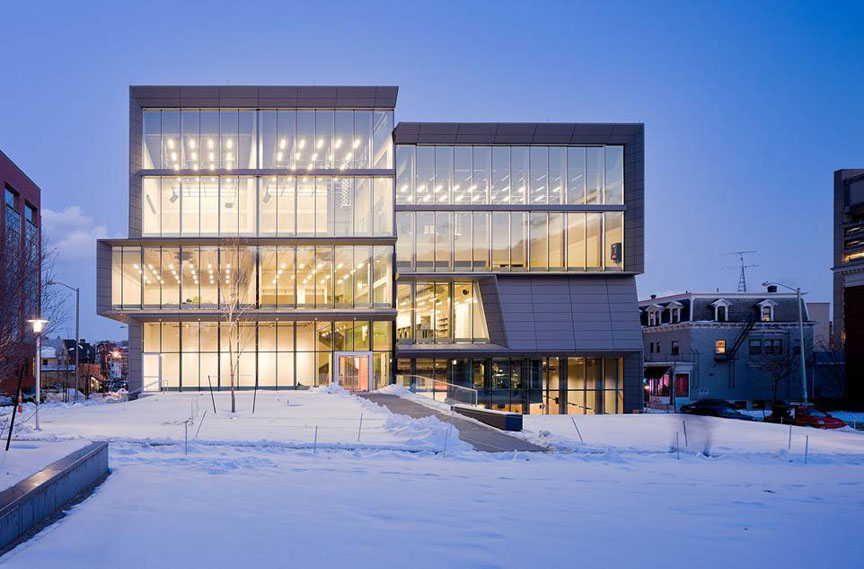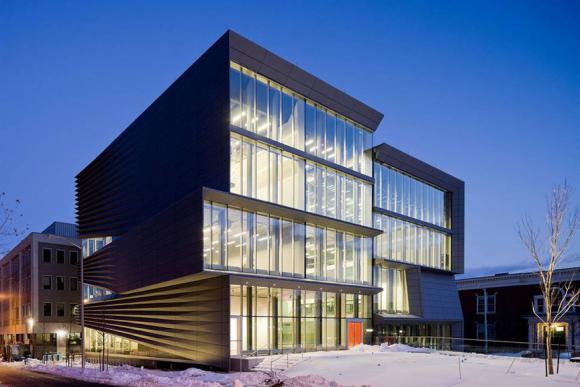PROVIDENCE, R.I. [Brown University] — Brown University will officially open the Perry and Marty Granoff Center for the Creative Arts Feb. 10, 2011. The interdisciplinary arts center will foster innovation, research, collaboration, creativity, and education among the arts, humanities, and sciences and will be a focal point of the University’s College Hill campus. The 38,815-square-foot, three-story building is designed by the New York-based architecture firm, Diller Scofidio + Renfro.
The $40-million Granoff Center is a revolutionary new building dedicated to encouraging faculty and students to create bold new directions for research, teaching, and production across the boundaries of individual arts disciplines and among artists, scientists, and scholars.
“The Granoff Center reaffirms the University’s belief that the arts are integral to a liberal education,” said Brown University President Ruth J. Simmons. “The Center builds on academic excellence at Brown and promotes multidisciplinary engagement among students and faculty. We especially wish to acknowledge the tireless work, leadership, and generosity of Marty and Perry Granoff, who, along with other donors, made this building possible.”
The Center features:
- The Martinos Auditorium, a 218-person auditorium and 35mm screening facility, which will serve as a performance venue and lecture hall.
- Four production studios for interdisciplinary work.
- The Cohen Gallery, which will host interdepartmental, student, and visiting artist exhibitions.
- A recording studio for professional sound recording, sound design, and multimedia work.
- The Khoo Teck Puat Multimedia Lab with equipment and software to allow students and faculty to create freely and stretch the boundaries of art and technology.
- The Cogut Physical Media Lab to be used for production of and research in sensors, robotics, and physical computing, primary areas of new research and teaching in the arts.
- An outdoor amphitheater wired for sound and video, allowing outdoor performances, film screenings, and installations.

“In creating the design for the Granoff Center, we needed structural elements that would stimulate the creative process from virtually every aspect of the building,” said Charles Renfro, partner-in-charge for the project. “The Granoff Center is a merger of architectural gesture and academic pedagogy. Our strategy was to encourage and illustrate collaboration across every level.”
“The Granoff Center is the embodiment of a movement that started 40 years ago to revisit the University’s approach to excellence in liberal arts education through cross-departmental ways to teach and learn,” said Richard Fishman, professor of visual art and director of the Creative Arts Council at Brown. “The building was designed specifically to serve the synergistic nature of the program. It encourages just the type of interdisciplinary collaboration Brown has historically been noted for, and will continue to develop in the future.”
The Granoff Center is an entirely donor-funded project. Marty Granoff, a Brown parent and member of the Corporation of Brown University, led the fundraising efforts. The Center was named in honor of Perry and Marty Granoff for their extraordinary leadership and generosity on behalf of the University.
“The Center is a groundbreaking and truly unique facility designed specifically for interdisciplinary work between various and often disparate arts disciplines. It puts Brown in the forefront of creating revolutionary and exciting areas of art,” Granoff said. “We are all looking forward to the results of what promises to be remarkable work and achievement.”
University students will attend their first classes in the Granoff Center on Wednesday, Jan. 26, 2011. Courses include “Experimental Musical Instrument Design,” “Curating Contemporary Art,” and “Narrative and Immersion.”
In addition, the building includes elements that will open the Center to the community, including the Cohen Gallery, which will house exhibitions and installations; performance spaces; and an outdoor amphitheatre. Loop, a Julianne Swartz exhibition, will inaugurate the Cohen Gallery on view from February 4 to March 20. Visit brown.edu/arts.
Design highlights
The Granoff Center is conceived as the next generation loft building with a twist. In addition to its large floor plates, high ceilings, and long structural spans that allow great flexibility, the architecture fosters a collaborative environment. The concept involves three stacked floor slabs that are cut in half and slipped vertically to create six half-levels divided by a shear glass wall. The intentional misalignment connects each studio to one above and below while still maintaining light, sound, and visual control. An internal stair connects all levels and doubles as the social hub of the building; its landings are expanded into furnished breakout spaces for serendipitous and planned encounters between students and faculty. The split-level strategy is also realized at the ground: The landscape in front of the building is split in two. One half is tilted up to form the entrance lobby and public gallery; the other half is tipped down into an outdoor amphitheater that flows into the recital hall. The transparent west facade is open to the campus and general public while the surrounding zinc skin is pleated at the sides to bring in light and view selectively.
The University worked with Shawmut Design and Construction to build the Granoff Center, which is targeting a gold certification from the U.S. Green Building Council’s Leadership in Energy and Environmental Design (LEED) program, the nationally accepted benchmark for the design, construction, and operation of high-performance green building. Apex Green Roofs designed the self-sustaining green roof and JaffeHolden designed acoustics for the Martinos Auditorium. An independent report on the economic impact of the Center’s construction and operation estimates the project created nearly 310 jobs in construction and related industries in Rhode Island.
A live netcam view of the building is available online.
Brown University
Founded in 1764, Brown University is the nation’s seventh-oldest institution of higher education and a member of the Ivy League. Globally acclaimed for its culture of independent thinking and academic excellence, Brown provides close mentoring of students and the vibrant engagement of a research-intensive university. Brown offers nearly 100 programs of study to its approximately 8,300 undergraduate, graduate, and medical students and employs nearly 700 full time faculty members. For more information, visit www.brown.edu.
Diller Scofidio + Renfro
Diller Scofidio + Renfro has designed the renovation and expansion of Lincoln Center in New York City, the new Institute of Contemporary Art on Boston Harbor, and the innovative High Line park in lower Manhattan. Projects in progress include the Berkeley Art Museum and Pacific Archive, the Museum of Image and Sound in Rio de Janeiro, Columbia University Business School, and an inflatable event space at the Hirshhorn Museum and Sculpture Garden in Washington, D.C.
In 1999, the MacArthur Foundation presented Elizabeth Diller and Ricardo Scofidio with the “genius” award for their interdisciplinary practice and commitment to integrating architecture with issues of contemporary culture. They were recently named international fellows of the Royal Institute of British Architects, and both were inducted into the American Academy of Arts and Sciences. Other awards and honors received by Diller Scofidio + Renfro include the National Design Award from the Smithsonian, the Brunner Prize from the American Academy of the Arts and Letters, the AIA President’s Award, the AIA Medal of Honor, and numerous AIA Honor Awards for projects including Alice Tully Hall, the ICA, and the High Line.

